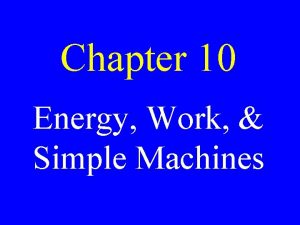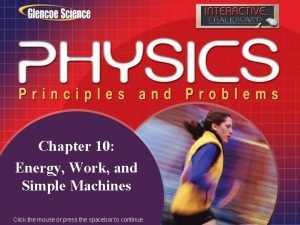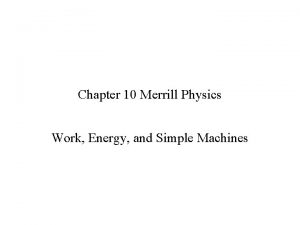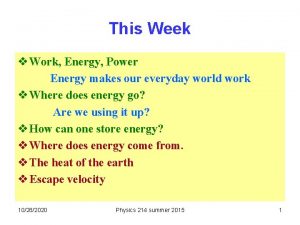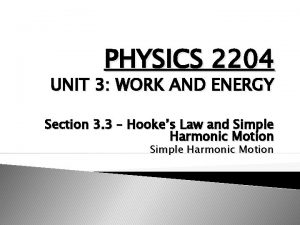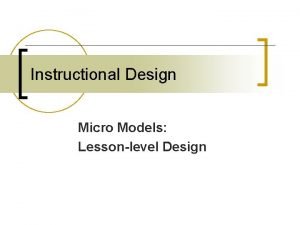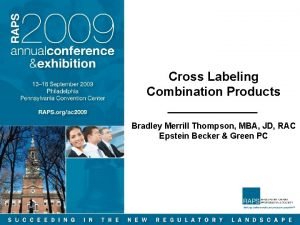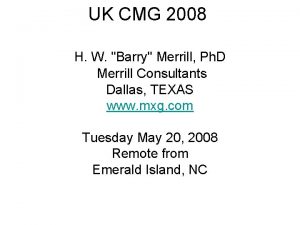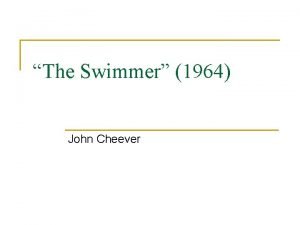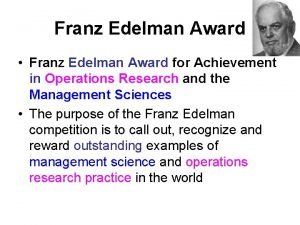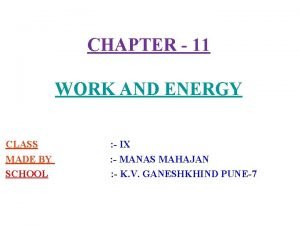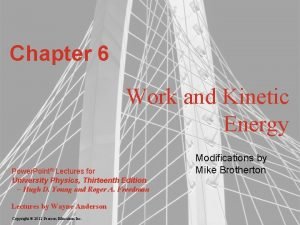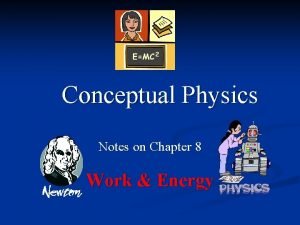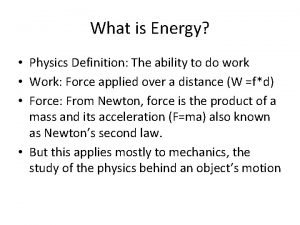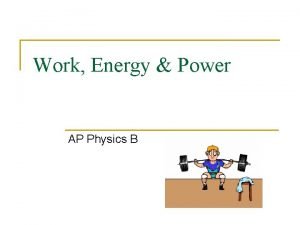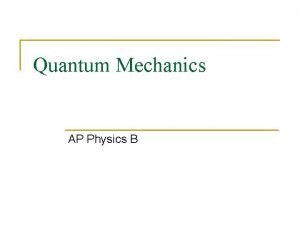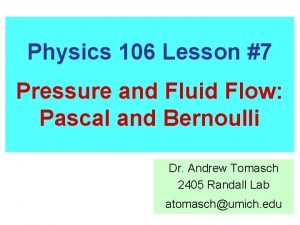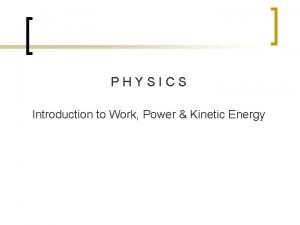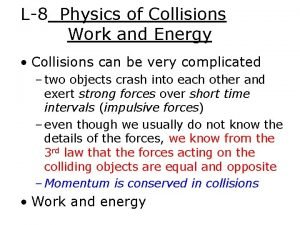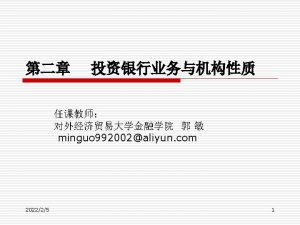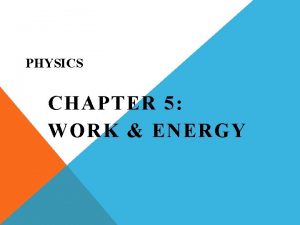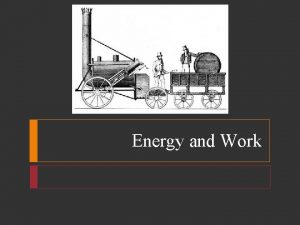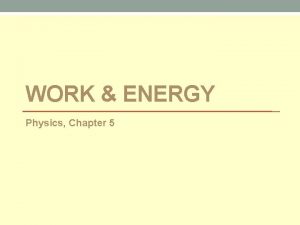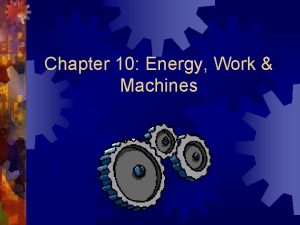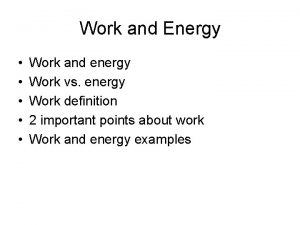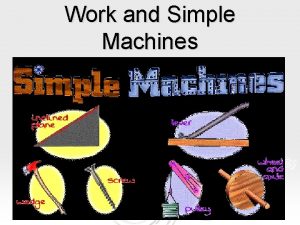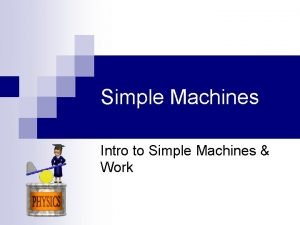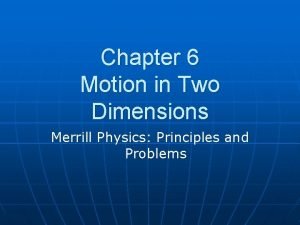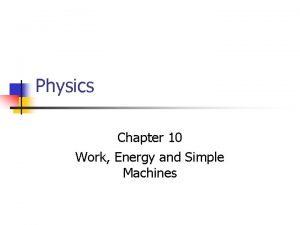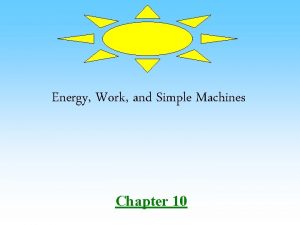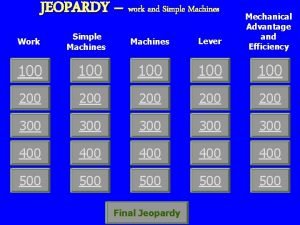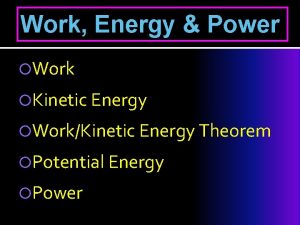Chapter 10 Merrill Physics Work Energy and Simple




















































- Slides: 52

Chapter 10 Merrill Physics Work, Energy, and Simple Machines

Section 10. 1 Objectives • Define work and energy • Calculate the work done by a force • Determine the force that does the work

A. What is work? • 1. Webster’s Definitions – a. “energy expended by a natural phenomenon” – b. “activity in which one exerts strength to do something”

2. Physics Definition of Work • a. Product of a force acting on an object and the displacement of the object in the direction of the force • b. W = Fd – (1) work is a scalar quantity – (2) displacement is critical - w/o movement no work is done

c. SI unit of work is the Newton-meter or JOULE – (1) A joule is the work done by a force of one newton as it acts through a distance of one meter along the line of the force – (2) Also use the joule to measure energy • d. Other units of work include the footpound, the erg, and the electron-volt (e. V)

Work Example A 50 N horizontal force is applied to a 15 kg crate of granola bars over a distance of 10 m. The amount of work this force does is W = 50 N · 10 m = 500 N · m 1 Joule = 1 Newton · meter, so we can say that the this applied force did 500 J of work on the crate. The work this applied force does is independent of the presence of any other forces, such as friction. It’s also independent of the mass. Tofu Almond Crunch 50 N 10 m

Negative Work A force that acts opposite to the direction of motion of an object does negative work. Suppose the crate of granola bars skids across the floor until friction brings it to a stop. The displacement is to the right, but the force of friction is to the left. Therefore, the amount of work friction does is -140 J. v Tofu Almond Crunch fk = 20 N 7 m

When zero work is done As the crate slides horizontally, the normal force and weight do no work at all, because they are perpendicular to the displacement. If the granola bar were moving vertically, such as in an elevator, then they each force would be doing work. Moving up in an elevator the normal force would do positive work, and the weight would do negative work. N Tofu Almond Crunch mg 7 m

No Work is Being Done! Why?

Force versus displacement Curve (pg. 199) • a. A graph which shows how force is applied to an object with respect to the object’s displacement from the starting point. • b. Area under the curve is the work done by the force over that distance.

Force vs. displacement example. F (N) 75 8. 0 What does the grey area represent? area = L W = ( area = LW = 75 N )( Fd= 8. 0 ) =m W d (m) The area under the curve 600 = Nm the work done 600 J

3. Examples of work calculations • a. A person exerts a vertical force of 30. 0 N on a pail as the pail is carried a horizontal distance of 8. 0 m at a constant speed. How much work does the 30 N force do on the pail? • You do no work, as the force is not along the lines of the distance moved. It would have to have been moved vertically for work to be done.

b. How much work do you do on an object of weight (mg) if: • (1) you lift it a distance of h meters straight up at constant speed; and, (2) you lower it through this same distance at a constant speed? • To lift you pull up on the object with a force F = mg to counteract the weight – W = Fd = mgh • When you lower the object F and d are in opposite directions, so W = mg(-h) = -mgh

4. Work and the Direction of Force • a. Only the component of the force in the direction of movement does work. The component of force perpendicular to the direction of motion does NO work. • Key Point to Remember - What is critical is to determine the component of force in direction of motion

b. Note as seen in a previous example you can have “negative” work • (1) although work is a scalar quantity, negative work means the force is applied in the opposite direction from the object’s motion. • (2) Work is also cumulative, so negative work will offset positive work.

When the force is at an angle When a force acts in a direction that is not in line with the displacement, only part of the force does work. The component of F that is parallel to the displacement does work, but the perpendicular component of F does zero work. So, a more general formula for work is W = F cos (d) F sin Tofu Almond Crunch F F cos d This formula assumes that F is constant.

• c. Example. Motion is in the x -direction Fy F Fx Motion d w = Fx d = (F cos ) d = F d cos is the angle between the applied force’s direction and the direction of motion

d. Special Work cases • • (1) = 0 o, cos = 1 and W = Fd (2) =180 o, cos = -1 and W = -Fd (3) = 90 o, cos = 0 and W = 0 (4) Note that if you push an object from point A to point B and then back to A, you would have no displacement, so net work done is zero.

e. Example: A man cleaning his apartment pulls a vacuum cleaner with a force of 50 N and angle of 30 o to the horizontal. A frictional force of 40 N retards his motion, and the vacuum is pulled a distance of 3 meters. • (1) Calculate the work done by the 50 N force • (2) Calculate the work done by the frictional force • (3) Calculate the net work done on the vacuum by all forces acting on it.

• First draw a picture or free body diagram FN Ff=40 N FA = 50 N motion W=mg

• W app force = (F cos )d = (50 N cos 30 o)(3 m)= = 130 Joules • Wf = (Ff cos )d = (40 cos 180 o)(3 m) = = -120 Joules (work is being done on the vacuum by rug) • m g and FN do no work, so Wnet = Wf + WAF FN Ff=40 N FA = 50 N =30 W=mg motion

Work and Energy, Section 10. 1 Assignment • Read pages 198 to 201 • Complete practice problems 1 thru 7, pgs 199 and 202 • Due Weds 2/26/2014

Power: Section 10. 1 Objectives (Part 2) • Understand the relationship between work done and energy transferred • Differentiate between work done and power required • Calculate work done and power required

The Work-Energy Theorem • a. work is equal to the change in energy that an object undergoes • b. work is the transfer of energy by mechanical means. • c. first established by Joule in nineteenth century • d. energy transfer can go both ways – from work on an object that increase the objects energy or work done by the object so that it transfers energy to its surroundings.

Power • 1. Power is the work done in a unit of time Power = Work Done time to do work P=W/t • 2. Basic units - work is in joules, time is in seconds, and power is in watts – a. 1 kilowatt = 1000 watts = 1000 joules/s – b. 1 horsepower = 746 watts

Please note that power is the timed rate at which work is being done. (joules/s) • 3. Examples – a. A motor lifts a 200 kg object straight up at a constant speed of 3. 00 cm/sec. What power is being developed by the motor? Express your answer in watts and horsepower.

• Givens: – Constant velocity so Fmotor = m g – m = 200 kg – v = 3. 00 cm/sec = 0. 0300 m/s so in one second the object moves 0. 0300 m • d = 0. 0300 m • t = 1 sec – w = m g = 1960 N • Find P. P = w / t and W = Fd

• W = (1960 N)(0. 03 m) 58. 8 Nm = 58. 8 J • P = W/t = 58. 8 J/1 sec = 58. 8 watts ( 1 HP/ 746 watts) =0. 0788 HP • NOTE Pavg = W/time = F( d)/ t = F vavg So power can be determined if you know a force causes an object to move a given distance at a constant speed

b. What average power is developed by an 800 N physics teacher while running at a constant speed up a flight of stairs rising 6 meters if he takes 8 seconds to complete the climb? • Givens: – F = w = 800 N – v = constant – d = 6 meters – t = 8 sec • P=Fd/t • P = 800 N(6 m)/8 s = 600 watts

c. A 50 kg student climbs a rope 5 m in length at a uniform speed and stops at the top. (1) What must her average speed have been in order to match the power output of a 200 watt bulb; (2) how much work did she do; and (3) how long did it take her to climb the rope? • Givens: – m = 50 kg –d=5 m – constant velocity so F = mg = 50 kg(9. 8 m/s 2) = 490 N – P = 200 watts • P = Fv so v = P/F

• v = P / F = 0. 408 m/s • W = Fd = 490 N (5 m) = 2450 Joules • t = d/v = 5 m/(0. 408 m/s) = 12. 25 sec • Or since P = W/t…. . t = W/P = 2450 J/200 W • = 12. 25 s

Chapter 10: Power Problems Assignment • Read Pages 202 -203 • Complete practice problems: 9 -11

Section 10. 2 Machines Objectives: • Explain why simple machines are useful • Calculate the mechanical advantage of ideal and real machines • Determine mechanical advantage of complex machines

Machines 1. What is a machine? • a. A device by which the magnitude, direction, or method of application of a force is changed so as to achieve some advantage. • b. NOTE: A machine does not change the amount of work done and does not make the amount of work done less, just makes it easier for someone to do a job.

Benefits of Machines


Simple Machines Ordinary machines are typically complicated combinations of simple machines. There are six types of simple machines: Simple Machine Example / description • Lever crowbar • Incline Plane ramp • Wedge chisel, knife • Screw drill bit, screw (combo of a wedge & incline plane) • Pulley wheel spins on its axle • Wheel & Axle door knob, tricycle wheel (wheel & axle spin together)

d. complex machines are made up of simple machines 2. Mechanical Advantage (MA) • a. Use a machine NOT to lessen work but usually to lessen the force required to do the work, to make the output work easier to achieve • b. Concerned with the work into a machine and the work out of the machine Wout Ideal Machine Win = Wout Win

c. In a real machine, however, this does not occur and Wout < Win • (1) Reason - input work energy is converted to heat due to friction • (2) Wout Real Machine Thermal Energy Win > Wout Win

d. Mechanical Advantage = MA = Fout / Fin or MA = Fresistance / Feffort = Fr / Fe • (1) Force ratio, so unit-less quantity • (2) If MA > 1, then machine has increased the force you applied to the object moved • (3) NOTE: the machine did not lessen the work output or input in any way.

Mechanical Advantage • Effort force – Fe • Resistance force – Fr • Mechanical Advantage • Fr / Fe

e. Ideal Mechanical Advantage (IMA) • (1) IMA = Din / Dout = De / Dr • (2) This is the Distance Ratio, and again it is unitless • (3) Design a machine to have a given IMA, then work to maximize efficiency and MA

3. Efficiency • (1) A ratio between MA and IMA expressed as a percent • (2) Efficiency = MA/IMA x 100% = W out / W in x 100%

Practice Problem A force of 1. 4 N is exerted through a distance of 40. 0 cm on a rope in a pulley system to lift a 0. 50 kg mass 10. 0 cm. Calculate the following: a. The MA MA = Fr/Fe = 0. 5 kg(9. 8 m/s 2)/1. 4 N = 3. 5 b. The IMA = de/dr = 40 cm/10 cm = 4. 0 c. The efficiency = MA/IMA x 100% = 3. 5/4. 0 = 87. 5%

More Problems: • a. A bottle opener required a force of 35 N to lift the cap of a bottle 0. 90 cm. The opener has an IMA of 8. 0 and an efficiency of 75%. • (1) What type of simple machine is the basis for the opener? • (2) What is the MA of the opener? • (3) What force is applied to the bottle cap? • (4) How far does the handle of the opener move?

The hardest part in any problem is to identify what items are what: • “what force is applied to the bottle cap? ” is asking for the Force out of the machine • And, “How far does the handle of the opener move? ” is asking for the Distance in • If you get confused, remember a machine is used to lessen the force in, and it does this by trading distance force. So the distance in will always be greater than distance out and Force out > force in.

• Givens: – Fin = 35 N – D out = 0. 90 cm = 0. 0090 m – IMA = 8. 0 – Efficiency = 75% • eff = MA / IMA x 100% – MA = eff x IMA =. 75 (8. 0) = 6. 0 note efficiency was converted to a decimal – MA = F out / F in

so F out = MA (F in) = (6. 0)(35 N) = 210 N • IMA = D in / D out so D in = IMA (D out) = 8. 0 (0. 90 cm) = 7. 2 cm

QUIZ - on separate sheet of paper • A worker uses a pulley to raise a 225 N carton 10 meters. A force of 110 N is required and the rope is pulled 30 m. • (1) What is the MA of the system? (2) What is the IMA of the system? (3) What is the efficiency of the system? • Givens: – F out = 225 N F in = 110 N – D out = 10 m D in = 30 m • MA = 2. 05 IMA = 3. 0 eff = 68%

QUIZ - on separate sheet of paper • What is the efficiency of a pulley if a force of 650 N acting through 15 meters is required to lift a 11, 000 N crate up a distance of 0. 750 meters? • Efficiency = MA/IMA x 100% = [(11000 N/650 N)/(15 m/0. 75 m)]x 100 = 84. 6%

Compound Machines

Section 10. 2 Assignment • Read pages 205 to 210 • Do Practice Problems 13 -15, pg 210
 Work energy theorem
Work energy theorem Section 4 review physical science
Section 4 review physical science Chapter 10 energy, work and simple machines answer key
Chapter 10 energy, work and simple machines answer key Chapter 10 energy, work and simple machines answer key
Chapter 10 energy, work and simple machines answer key Energy work and simple machines chapter 10 answers
Energy work and simple machines chapter 10 answers Physics 10
Physics 10 Work energy
Work energy What is work energy theorem
What is work energy theorem Sources of chemical energy
Sources of chemical energy Regents physics work power energy
Regents physics work power energy Joule units
Joule units Physics 2204 unit 3: work, power, energy
Physics 2204 unit 3: work, power, energy Chemical potential energy images
Chemical potential energy images Energy energy transfer and general energy analysis
Energy energy transfer and general energy analysis Energy energy transfer and general energy analysis
Energy energy transfer and general energy analysis Dr merrill barry
Dr merrill barry Capacoo
Capacoo Merrill's first principles of instruction
Merrill's first principles of instruction Dr. sonya merrill
Dr. sonya merrill Modelo de merrill
Modelo de merrill Merrill lynch strategic balanced index
Merrill lynch strategic balanced index Bradley merrill thompson
Bradley merrill thompson Dr merrill barry
Dr merrill barry Dr sonya merrill
Dr sonya merrill Dr sonya merrill
Dr sonya merrill Dr barry merrill
Dr barry merrill Neddy merrill
Neddy merrill Terman merril que mide
Terman merril que mide Franz edelman award
Franz edelman award Chapter 11 work and energy
Chapter 11 work and energy Chapter 6 work and energy powerpoint
Chapter 6 work and energy powerpoint Conceptual physics chapter 8
Conceptual physics chapter 8 Simple present simple future
Simple present simple future Why does it happen
Why does it happen University physics with modern physics fifteenth edition
University physics with modern physics fifteenth edition Ia topics for physics
Ia topics for physics Chapter 7 energy conservation of energy
Chapter 7 energy conservation of energy Physics what is energy
Physics what is energy Simple future past
Simple future past Present simple past simple future simple
Present simple past simple future simple Simple past simple present simple future
Simple past simple present simple future Without information
Without information Past present simple
Past present simple Present past future sentences
Present past future sentences Present simple past simple future simple
Present simple past simple future simple Future simple present simple
Future simple present simple Smart vs hard working
Smart vs hard working Ap physics power
Ap physics power Work and power worksheet #1
Work and power worksheet #1 What is work function in physics
What is work function in physics Hydrostatics
Hydrostatics Power versus work
Power versus work Work physics definition
Work physics definition



